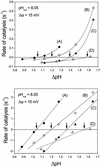H+/ATP ratio of proton transport-coupled ATP synthesis and hydrolysis catalysed by CF0F1-liposomes
- PMID: 12554643
- PMCID: PMC140756
- DOI: 10.1093/emboj/cdg073
H+/ATP ratio of proton transport-coupled ATP synthesis and hydrolysis catalysed by CF0F1-liposomes
Abstract
The H(+)/ATP ratio and the standard Gibbs free energy of ATP synthesis were determined with a new method using a chemiosmotic model system. The purified H(+)-translocating ATP synthase from chloroplasts was reconstituted into phosphatidylcholine/phosphatidic acid liposomes. During reconstitution, the internal phase was equilibrated with the reconstitution medium, and thereby the pH of the internal liposomal phase, pH(in), could be measured with a conventional glass electrode. The rates of ATP synthesis and hydrolysis were measured with the luciferin/luciferase assay after an acid-base transition at different [ATP]/([ADP][P(i)]) ratios as a function of deltapH, analysing the range from the ATP synthesis to the ATP hydrolysis direction and the deltapH at equilibrium, deltapH (eq) (zero net rate), was determined. The analysis of the [ATP]/([ADP][P(i)]) ratio as a function of deltapH (eq) and of the transmembrane electrochemical potential difference, delta micro approximately (H)(+) (eq), resulted in H(+)/ATP ratios of 3.9 +/- 0.2 at pH 8.45 and 4.0 +/- 0.3 at pH 8.05. The standard Gibbs free energies of ATP synthesis were determined to be 37 +/- 2 kJ/mol at pH 8.45 and 36 +/- 3 kJ/mol at pH 8.05.
Figures






Similar articles
-
The thermodynamic H+/ATP ratios of the H+-ATPsynthases from chloroplasts and Escherichia coli.Proc Natl Acad Sci U S A. 2008 Mar 11;105(10):3745-50. doi: 10.1073/pnas.0708356105. Epub 2008 Mar 3. Proc Natl Acad Sci U S A. 2008. PMID: 18316723 Free PMC article.
-
Thermodynamics of proton transport coupled ATP synthesis.Biochim Biophys Acta. 2016 Jun;1857(6):653-64. doi: 10.1016/j.bbabio.2016.02.019. Epub 2016 Mar 3. Biochim Biophys Acta. 2016. PMID: 26940516
-
Comparison of DeltapH- and Delta***φ***-driven ATP synthesis catalyzed by the H(+)-ATPases from Escherichia coli or chloroplasts reconstituted into liposomes.FEBS Lett. 1999 Sep 3;457(3):327-32. doi: 10.1016/s0014-5793(99)01060-1. FEBS Lett. 1999. PMID: 10471802
-
ATP hydrolysis in ATP synthases can be differently coupled to proton transport and modulated by ADP and phosphate: a structure based model of the mechanism.Biochim Biophys Acta. 2010 Jun-Jul;1797(6-7):755-62. doi: 10.1016/j.bbabio.2010.03.007. Epub 2010 Mar 15. Biochim Biophys Acta. 2010. PMID: 20230778 Review.
-
Modulation of proton pumping efficiency in bacterial ATP synthases.Biochim Biophys Acta. 2006 May-Jun;1757(5-6):320-5. doi: 10.1016/j.bbabio.2006.04.018. Epub 2006 May 4. Biochim Biophys Acta. 2006. PMID: 16765908 Review.
Cited by
-
Direct observation of stepped proteolipid ring rotation in E. coli F₀F₁-ATP synthase.EMBO J. 2010 Dec 1;29(23):3911-23. doi: 10.1038/emboj.2010.259. Epub 2010 Oct 29. EMBO J. 2010. PMID: 21037553 Free PMC article.
-
Regulation of cyclic electron flow in Chlamydomonas reinhardtii under fluctuating carbon availability.Photosynth Res. 2013 Nov;117(1-3):449-59. doi: 10.1007/s11120-013-9932-0. Epub 2013 Oct 10. Photosynth Res. 2013. PMID: 24113925
-
Crystallization of the c14-rotor of the chloroplast ATP synthase reveals that it contains pigments.Biochim Biophys Acta. 2008 Jul-Aug;1777(7-8):605-12. doi: 10.1016/j.bbabio.2008.05.009. Epub 2008 May 19. Biochim Biophys Acta. 2008. PMID: 18515064 Free PMC article.
-
Determination of torque generation from the power stroke of Escherichia coli F1-ATPase.Biochim Biophys Acta. 2008 Jul-Aug;1777(7-8):579-82. doi: 10.1016/j.bbabio.2008.04.016. Epub 2008 Apr 18. Biochim Biophys Acta. 2008. PMID: 18471428 Free PMC article.
-
One rotary mechanism for F1-ATPase over ATP concentrations from millimolar down to nanomolar.Biophys J. 2005 Mar;88(3):2047-56. doi: 10.1529/biophysj.104.054668. Epub 2004 Dec 30. Biophys J. 2005. PMID: 15626703 Free PMC article.
References
-
- Böttcher B. and Gräber,P. (2000) The structure of the H+-ATP synthase from chloroplasts and its subcomplexes as revealed by electron microscopy. Biochim. Biophys. Acta, 1458, 404–416. - PubMed
-
- Boyer P.D. (1998) ATP synthase—past and future. Biochim. Biophys. Acta, 1365, 3–9. - PubMed
-
- Davenport J.W. and McCarty,R.E. (1984) An analysis of proton fluxes coupled to electron transport and ATP synthesis in chloroplast thylakoids. Biochim. Biophys. Acta, 766, 363–374.
-
- Ferguson S.J. (2000) ATP synthase: what dictated the size of a ring? Curr. Biol., 10, R804–R808. - PubMed
Publication types
MeSH terms
Substances
LinkOut - more resources
Full Text Sources
Other Literature Sources
Research Materials
Miscellaneous

